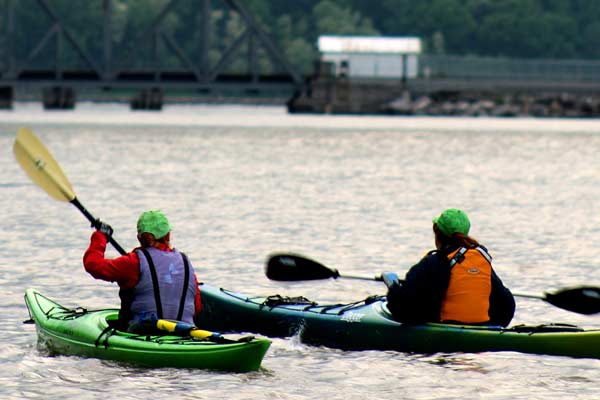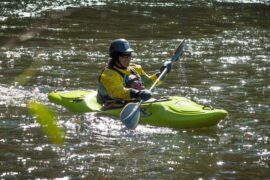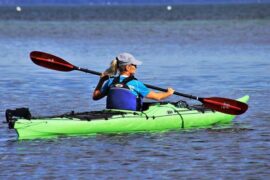Since kayaking is thrilling and enjoyable, most individuals become hooked on the sport.
Most people, however, are apprehensive about trying kayaking due to their size. Even so, most kayaks we have seen in stores or online are made for much smaller people.
You might be a significant person curious if overweight people can go kayaking. But make sure to pick a kayak that can hold your weight. Paddling a kayak does not necessitate a specific body type or gender in its users.
Choosing the correct kayak is essential if you are a larger paddler looking to enjoy the sport. Several larger-sized kayaks are now available to buy. These boats are great for overweight people as they have more oversized frames and lots of room.
How to Choose a Kayak for Overweight People?
Kayaks aren’t often built for huge people; therefore, the query could be rephrased to focus on that group instead.
Even if a man and a woman are identical in size, that doesn’t mean they’ll be able to sit side by side in a boat. However, that is more of a problem with how the seat is designed to accommodate different-sized hips. Take into consideration the following variables:
Optimum Paddler Weight
Find the enormous kayak’s recommended weight range once you’ve decided on the kayak you want. This is typically labeled as “optimum paddler weight” and offered as a scale in both kilos and pounds.
As a result of extensive testing, the weight range provides the best performance relative to displacement. Higher weights cause boats to ride lower in the water, reducing speed and handling and increasing the likelihood that they will scrape the bottom or run aground on submerged rocks.
Following that, think about how much you weigh. Sit-inside whitewater kayaks can usually hold up to about 300 pounds. Sit-on-tops have weight limits of up to 500 pounds.
Comfort
You should try sitting in or on the kayak in the store to determine if it is comfortable and will suit your needs.
Keep in mind that you’ll probably spend multiple hours at a time on the boat. Does it offer adequate back support, being snug without being too tight, and can it be customized to your needs?
Engage a trustworthy salesperson for help and answers to your queries. Unless you’ve tried sitting in a kayak beforehand, you shouldn’t just order one online and hope it fits.
Weight of the Kayak
Take note of how heavy that kayak is. Remember that it may be necessary to travel some distance to transport your boat from its storage location to your vehicle and, finally, to the ocean.
Style
When shopping, it’s common to have several color options for the model you’ve settled on.
In other words, you need a boat that makes you look and feel beautiful. You can be bold and unique here. Photos and videos look better in brighter colored kayaks.
Price
Lastly, consider how much cash you have and how desperately you need it. You can decide whether to purchase a brand new or pre-owned kayak or establish a savings target.
If you factor in a PFD and a paddle, you could be looking at an initial cost of at least $500 – $1,000.
How Does an Overweight Person Get in a Kayak?
Extra caution should be taken when using a kayak if you are overweight. The situation could get worse if THERE’S haste or error. To ensure the kayak’s stability, dip it in the waters halfway.
If you need to steady yourself, grab the paddle and hold it across your thighs. Putting both legs in at once will cause the boat to capsize, and you will be thrown overboard.
Once you and your friend are comfortably seated, ask your friend to push the kayak in and out of the waters for you.
If you’re alone, detach your paddle and turn it around. Use your weight to push off the ground with those paddle’s narrow ends, launching your kayak into the waters.
Is Any Consequence to Exceeding the Weight Limit When Using a Fishing Kayak?
This is the moment when water begins to enter the kayak’s cockpit. It probably won’t sink you immediately, but it will worsen things. The waterline of the sit-on-top kayak may drop if you weigh more than the recommended limit.
However, exceeding the limit still places you lower in the water and disrupts stability, even though water is not taken on. Paddling alone will cause you to capsize.
Always remember that there are two sorts of stability: primary (when stationary) and secondary (when in motion).
Overshooting the limit might not always endanger your primary stability, but it could affect your secondary stability, putting you at risk.
Overweight people should take the rear seat in a tandem kayak. The nose of the kayak will be raised, making it easier to steer. You’ll slow down and maybe lose control if your stern and deck dig into the water.
Kayaking Tips for Overweight Paddlers
- Put on a PFD that fits you correctly at all times.
- Keep hydrated
- Group up with other paddlers who can help you load and unload your kayak and enter and exit the watercraft.
- Demo a boat before buying one.
- If you’re starting and don’t have much upper body strength, you might want to look into a pedal/paddle hybrid to save your arms and shoulders from getting tired.
- Always have a solid step stool in the car. You can quickly secure your kayak to your car with these.
- Protect the car’s floor with a kitchen mat so you can slip your kayak on the roof instead of lifting it.
- Get a poncho with plenty of room to change inside instead of cramming it into your car.
Conclusion
Kayaking is a sport that can be enjoyed by people of various shapes and sizes, making it a perfect activity for people who want to be active while still appreciating nature.
If you have never been kayaking before, renting a kayak or enrolling in a kayaking class for beginners is the best way to get started.
Even if you carry a few more pounds, with little experience, you can paddle like an expert. Have fun and be safe while kayaking on the water.




